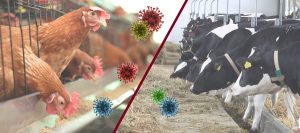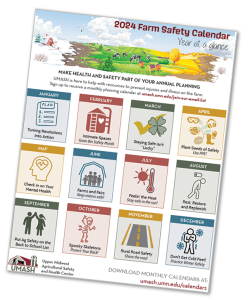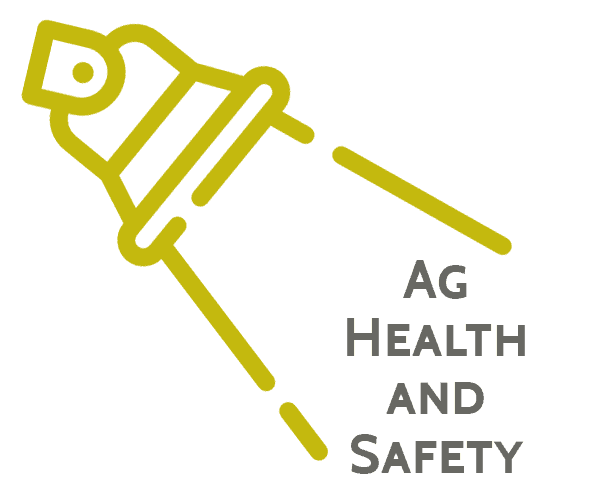UMASH – the Upper Midwest Agricultural Safety and Health Center – brings a multidisciplinary approach guided by One Health principles to improve the health and safety of agricultural workers and their families in the Upper Midwest region.
LEARN MORE
Explore how UMASH is working to promote health and safety on the farm!
- September 10, 2025Where Safety Meets Fun: UMASH Wellness Pavilion at Farmfest 2025For the seventh year, on August 5-7, 2025, UMASH hosted the UMASH Wellness Pavilion at Minnesota Farmfest, the largest farm show in Minnesota. [...] READ MORE
- June 27, 2025Growing Through Change: Innovating, Collaborating, and Supporting our CommunityJUNE 2025 As the seasons shift, so do the challenges and opportunities in agriculture. In recent months, the UMASH team has continued to promote health and safety across Upper Midwest agricultural communities, even amid uncertainty around federal support. Through it all, UMASH and our partners remain committed to growing through change and continuing to promote farm safety and health by innovating, collaborating, and supporting those who matter most: you, our community. Here’s a look at what we’ve been working on over the past few months. Looking Ahead: Dr. Jeff Bender Shares Update on UMASH Future Emerging and Evolving Challenges in Ag In March 2025, UMASH Center Director Dr. Jeff Bender presented on the etiology and epidemiology of H5N1 avian influenza at the Scowcroft Institute’s Pandemic Policy Summit in Washington, DC, sharing insights on the importance of implementing biosecurity measures on farms, and underscoring the need for better protections for farmworkers, producers, and veterinarians. In March 2025, UMASH Outreach Director and Center Coordinator Megan Schossow presented at the Minnesota Public Health Association’s Policy Roundtable, participating in discussions about rural mental health policy, access to resources, and community-centered solutions. Gear up for Ag: Veterinary Program: In an ongoing collaboration, UMASH and the Ag Health and Safety Alliance have come together to create safety training materials for veterinary students through the Gear Up for Ag: Veterinary Program. Earlier this year, project team members Dr. Julie Gibbs and Caroline Sheridan debuted the veterinary-focused safety curriculum at two major events: the IVMA Conference (February 2025, Altoona, PA) and HICAHS Research Day (April 2025, Fort Collins, CO), helping promote the safety of future veterinarians, vet-techs, and vet assistants working in livestock operations. Mayo Rural Medicine Selective: In addition, in early June 2025, Dr. Jeff Bender and Dr. Beth Baker led a rural medicine selective course for Mayo Alix Clinic School of Medicine students, engaging them in conversations about the health care needs of rural and agricultural communities. Student Voices in Farm Safety ISASH Conference 2025: In June 2025, agricultural safety and health professionals gathered from around the world for the International Society for Agricultural Safety & Health (ISASH) Annual Conference in Portland, Maine. UMASH highlights from the conference include an oral session and a research poster on the Telling the Story Project, featuring collaboration with University of Minnesota’s Agricultural Education, Communication & Marketing (AECM) program. Not only did the TTSP poster win first-place, but it showcased how storytelling and media education are helping ag students share powerful, injury prevention messages and build farm safety awareness among agricultural communities. UMASH Farm Safety and Health PSA Contest: Now in its fifth year, the UMASH Ag Health and Safety PSA Video Contest continues to combine student creativity with farm safety awareness. In partnership with the University of Minnesota’s Agricultural Education, Communication and Marketing program, the contest gives students a platform to turn real-world agricultural safety issues into powerful visual messages. This year’s winners, Selena Corona and Lindsey Miller, created engaging PSAs focused on rural roadway safety and farmer mental health. Explore the Latest Resources and Publications from UMASH New UMASH Publication The Landscape of Farmer Mental Health Programs in the US Midwest Journal of Agromedicine – Florence Becot,Sarah Ruszkowski,Carrie Henning-Smith, Andrea Bjornestad Signs and Symptoms of Stress on the Farm Recognize the signs of stress and know when to reach out for support with UMASH’s updated Signs and Symptoms of Stress Posters, available in English and Spanish. Find more stress and mental health resources and download the posters at: umash.umn.edu/stress [...] READ MORE
- May 21, 2025Farm Safety in Focus: Students Craft Award-Winning Videos in UMASH ContestMAY 2025 Now in its fifth year, the UMASH Ag Health and Safety PSA Video Contest continues to bring student creativity and farm safety awareness together. This unique collaboration between UMASH and Dr. Troy McKay’s Advanced Video Production for Agriculture, Food, and the Environment (AECM 4432) course gives students a platform to turn real-world agricultural safety issues into powerful visual messages. Guided by UMASH’s expertise and Dr. McKay’s mentorship, students channeled their creativity and put their media skills to the test to advocate for a safer and healthier future for agriculture. Student Ag PSA Video Contest Producing short, impactful public service announcements (PSAs), students address a range of topics from equipment safety and chemical exposure to mental health and zoonotic disease, helping to raise farm safety awareness within agricultural communities. Student participants focused on topics like farm equipment safety, rural roadway safety, mental health, and more. 2025 Winning PSAs Two student videos were selected as winners in this year’s PSA contest. Each winner received a University of Minnesota bookstore gift card and received a feature on UMASH channels in recognition for their contributions. Creating a Culture of Ag Safety in Media UMASH is grateful to collaborate with Dr. Troy McKay and the Agricultural Education, Communication and Marketing (AECM) department at the University of Minnesota. Through their mentorship and guidance, they are promoting experiential learning that blends communication, creativity, and real-world impact in agricultural safety and health. Thank you to Dr. McKay and the AECM department for your collaboration and dedication to this important work. [...] READ MORE
- April 3, 2025Farm Safety and Health in Action: UMASH’s Latest CollaborationsMARCH 2025 In recent months, the UMASH team has been actively engaged in strengthening the health and safety of agricultural communities across the Upper Midwest, focusing on issues ranging from farm health, safety, and biosecurity to mental health support, farm safety education, and awareness. Through partnerships, outreach, and innovative research, UMASH is working to address both current and emerging challenges in the agricultural sector. Here’s a recap of how UMASH’s collaborative efforts are working to create safer, healthier farming communities. Farm Health, Safety, and Biosecurity As avian influenza outbreaks continue to impact dairy and poultry farms, UMASH has partnered with the MCN Clinicians Network and the National Center for Farmworker Health to keep farmworkers and clinicians informed. In a recent webinar, UMASH Center Director and Associate Director, Dr. Jeff Bender and Amy Liebman joined Dr. Laszlo Madaras (MCN) to discuss H5N1 during influenza season. The team shared the latest strategies to stay safe and stop the spread of avian flu and influenza for those working in dairy and poultry industries. Watch the full recorded session here: Bird Flu & Farmworkers: An Update on H5N1 During Influenza Season. Exploring Emerging Agricultural Risks In December 2024, UMASH team members Dr. Bender, Outreach Director and Center Coordinator Megan Schossow, and Senior Communications Manager and Evaluation Specialist Cassie Edlund attended the Minnesota Department of Health’s 9th Annual Emerging Issues Forum, where they discussed key challenges like avian flu, heat stress, and health access in agricultural communities. The team participated in critical conversations about how these issues affect both farmworkers and farmers, and the steps we can take to improve safety and health in these environments. Firefighter Safety and Agricultural Housing: In December 2024, UMASH’s RF-DASH – Rural Firefighters Delivering Agricultural Safety project teams teamed up with the National Center for Farmworker Health to host a webinar focused on farmworker housing standards and emergency response strategies. The session was designed for firefighters and first responders, giving them a better understanding of farmworker housing and how to improve incident prevention, reduce property loss, and better engage with agricultural communities in emergency preparedness. Farmers’ Mental Health: Seeking Solutions: Farming is more than just physically demanding. It can be mentally, emotionally, and financially challenging too. Recognizing the growing need to address this issue and provide resources, UMASH research project teams are leading an innovative research project to better understand farmers’ mental health. To better understand farmers’ mental health support needs, researchers from Pennsylvania State University, University of Minnesota, and South Dakota State University are seeking farmers in Minnesota, South Dakota, and Wisconsin to share their experiences in one-hour interviews via phone or Zoom. Learn more or schedule an interview. Airborne Viruses & Bacteria in Animal Ag: At the 2025 Conference of Research Workers in Animal Disease in Chicago this January, UMASH’s research team presented their initial findings on the transmission of airborne viruses and bacteria in animal agriculture. The team presented on comparing environmental and personal air sampling methods for microbiome analysis of samples collected on farms. Telling the Story Project: Using Real-Life Stories to Prevent Farm Injuries In February 2025, the Telling the Story Project team released their 15th story: Eric’s story, which shares about a veterinarian who survived near-fatal cattle chute injuries. Telling the Story project is a collaboration between three agricultural safety and health centers funded by the National Institute for Occupational Safety and Health (NIOSH) — the Upper Midwest Agricultural Safety and Health Center, the Central States Center for Agricultural Safety and Health, and the National Children’s Center for Rural and Agricultural Health and Safety – as well as the National Farm Medicine Center. Farm Safety in the Classroom: Conversations for a Safer Tomorrow Megan Schossow partnered with Cassie Edlund to launch the 5th year of UMASH’s collaboration with University of Minnesota students. This year, U of M CFANS students in Agricultural Education, Communication, and Marketing worked to create short, impactful public service announcements (PSAs) focused on farm safety and health. Check out last year’s winning PSAs here: Lights, Camera, Action for Ag Safety and Health. Growing Wellness and Awareness In February 2025, UMASH participated in Ag Safety Awareness Program Week (ASAP Week). American Farm Bureau Federation’s Ag Safety Awareness Program (ASAP) Week was created to bring awareness to safety and health issues facing the agriculture industry. Alongside the U.S. Agricultural Safety and Health Centers, Farm Bureau is working to help keep agricultural communities safe and healthy by encouraging farmers and ranchers to keep safety top-of-mind with this year’s theme: “Planting Safely, Growing Wellness.” From youth safety, disaster preparedness, and grain bin safety, each day UMASH highlighted safety resources to support health, safety and wellness on farms for families and communities. Explore the Latest Resources and Publications from UMASH Health and Safety Training for Immigrant Dairy Workers in the Upper Midwest Journal of Dairy Science – Vázquez R, Charlier D, Peterson C, Kirsch J, Liebman A, Bender J. H5N1: Stay Safe and Help Stop the Spread UPDATED TOOLKIT NOW AVAILABLE! H5N1 (bird flu) continues to spread among dairy herds and poultry flocks. While the risk to the general public is low, those who work with infected animals or their byproducts (like raw milk), such as dairy and poultry workers, are at higher risk of getting sick from the virus. UMASH has prepared a toolkit with resources from UMASH and our farm safety and health partners to learn what farmers, farm workers, and clinicians can do to help prevent the spread of bird flu and stay safe. [...] READ MORE
- January 21, 2025Understanding Farmers’ Mental Health Challenges and Seeking SolutionsJANUARY 2025 Farming is more than just physically demanding—it can be mentally, emotionally, and financially challenging too. Farm families and rural communities navigate a complex web of financial, social, and environmental challenges, which can contribute to elevated rates of stress, anxiety, and depression. Recognizing the growing need to address this issue and provide resources, Upper Midwest Agricultural Safety and Health Center (UMASH) research project teams are leading an innovative research project to better understand farmers’ mental health. This first-of-its-kind study focuses on how farmers decide to seek help, their help-seeking behaviors, and the factors—both personal and external—that influence these decisions. Researchers are now seeking direct input from farmers. Share your insights! Farmers Needed for Financial and Mental Well-Being Interviews Digging Deeper into Farmers’ Mental Health Support Needs What’s Next: Gathering Farmers’ Insights to Shape Future Support As the research continues, the team is moving into the next phase: seeking direct input from farmers. Researchers are conducting one-hour interviews with farmers in Minnesota, South Dakota, and Wisconsin to better understand how they solve challenges related to financial and mental well-being. This input will provide critical insights needed to develop more effective, targeted programs and policies that will help support farm families in navigating the unique pressures they face. Listening to Farmers: Problem Solving for Financial and Mental Well-Being To better understand farmers’ mental health support needs, researchers from Pennsylvania State University, University of Minnesota, and South Dakota State University are seeking farmers in Minnesota, South Dakota, and Wisconsin to share their experiences in fixing problems on and off the farm, including those connected to financial and mental well-being. Insights gathered from these one-hour phone or Zoom interviews will help shape policies and programs that better support farm families. All responses will be kept anonymous and summarized for sharing with policymakers, farm organizations, and service providers. Farmers’ input will play a critical role in creating actionable recommendations to strengthen future programs and policies to support the health, well-being, and economic viability of farm communities. The team will share anonymous summaries of what farmers talked about during the interviews with policymakers, farm organizations, and service providers. The team will also develop recommendations regarding future programs and policies to support the health, well-being, and economic viability of farm families. The interviews will take place between January and April and farmers will be compensated $50 for their time. How to Participate: To schedule an interview or learn more, visit: https://redcap.ctsi.psu.edu/surveys/. Farmers can also request more information and a paper sign-up form by contacting the project manager, Sarah Ruszkowski (sarah.ruszkowski@psu.edu; 814-865-4982). For further about the research project, contact the project lead: Florence Becot ( florence.becot@psu.edu ; 814-865-1783). [...] READ MORE
- November 20, 2024Building Safer, Healthier Farms: From our Backyard to BeyondNOVEMBER 2024 As fall unfolds, UMASH continues to advance agricultural health and safety through outreach, training, and collaboration across the Upper Midwest and beyond. Here’s a recap of how UMASH partnership, events and research is working to build safer, healthier farming communities in our backyard in the Upper Midwest and beyond. Cultivating a Culture of Safety on Dairy Farms UMASH Sponsors Safety Session at Dairy Girl Network National Conference From November 5-7, UMASH Outreach Director Megan Schossow represented UMASH at the Dairy Girl Network’s Forward TogetHER National Conference in Kansas City, Missouri. Sponsoring the session “Building a Culture of Safety,” UMASH along with farm safety and health partners from Milc Group and the Pagel’s Ponderosa Dairy, provided actionable insights to improve safety and health practices in the dairy industry. Partnering with FARM to Bring Safety to Dairies Schossow also teamed up with David Douphrate, Associate Professor at the Texas A&M University School of Public Health, and the FARM Program in November to contribute to the Workforce Development (FARM WFD) session. Together, they shared strategies for fostering a culture of safety on dairy farms. The FARM WFD Program, a key initiative of the National Dairy FARM Program, is dedicated to improving HR and safety standards within the dairy industry. By equipping FARM Program Evaluators with critical knowledge and tools, the program works to support dairy producers in enhancing their safety practices and overall workforce development. LEARN MORE HERE Collaboration for Safer Swine Production Gaining and Sharing Insights From October 15-16, UMASH’s Center Director Dr. Jeff Bender, Outreach Director Megan Schossow, and NIOSH Ag Health and Safety program leadership, Dr. Jennifer Lincoln and Dr. John Gibbins, attended a Swine Safety Roundtable at the National Pork Board Office in Des Moines, Iowa. Associate Director Amy Liebman joined virtually to facilitate a discussion on heat stress standards for workers. The group, which included representatives from Agricultural Safety and Health Council of America (ASHCA) and pork producers, discussed critical issues like worker safety, heat stress management, and enhancing research and safety training, exchanging insights and strategies to improve health and safety in the swine industry. Sharing critical insights with pork producers across the Upper Midwest, UMASH research project team members (Factors influencing transmission of airborne viruses and bacteria in animal agriculture) attended the Allen D. Leman Swine Conference in St. Paul, Minnesota, from September 21-24. The team highlighted their latest findings on airborne virus transmission in swine facilities, sparking discussions on the essential occupational health and safety measures needed to protect swine workers and reduce exposure risks. One Health In Action UMASH Showcases One Health Initiatives at National Events Hosted in Minneapolis, Minnesota, for the second time since 1971, the American Public Health Association (APHA) Annual Meeting welcomed public health professionals, students, faculty, and staff to network and discuss the latest discoveries in public health from October 27-30. UMASH Center Director Dr. Jeff Bender was featured as a presenter in a collaborative session around One Health and how a culturally responsive One Health framework can advance safety on Upper Midwest dairy farms. Other UMASH attendees included Associate Director Amy Liebman and Outreach Director Megan Schossow. On November 1, Dr. Jeff Bender delivered a keynote at the University of Kentucky’s One Health Symposium in Lexington, hosted by the new One Health Center at the Martin-Gatton College of Agriculture, Food, and Environment, under Dr. Reddy Palli’s leadership. Speaking on “One Health, One Vision,” Dr. Bender engaged over 100 attendees, discussing the role of partnerships in fostering safer, healthier communities and emphasizing UMASH’s collaborative approach to One Health. Training, Connecting and Innovating for Agricultural Safety and Health Ag Rescue Ready: Hands-On Training for Emergency Preparedness Seventy-eight participants gathered in Marshfield, Wisconsin, from October 25-26 for an Ag Rescue Training Event led by the National Farm Medicine Center and partners like Pittsville Fire Co. and Marshfield Clinic Health System. Farmers, first responders, and health professionals engaged in live demonstrations and hands-on workshops focused on tractor rollovers, large animal rescues, grain bin and confined space rescues, and more. The event also included Rural firefighters delivering ag safety and health (RF-DASH) training, providing essential skills to strengthen emergency preparedness and safety on farms. Exchanging and Engaging for Safer Agritourism On October 27, Outreach Director and Center Coordinator Megan Schossow visited Duluth, MN, to attend The Agritourism Exchange: a networking event for agritourism farmers with representatives from the Minnesota Department of Health, Minnesota Department of Agriculture (including Minnesota Grown), Minnesota Farmers Union, Sustainable Farming Association, and UMASH to share valuable resources and insights about safety and health practices when conducting agritourism activities. Making Messages Matter in Farm Safety and Health UMASH staff and researchers gathered in Ames, Iowa, from November 6-8, 2024, for the Midwest Rural Agricultural Safety and Health Conference (MRASH). Centered around the theme “Messaging Matters,” this year’s conference highlighted effective communication in agricultural safety and health. UMASH representatives participated in discussions on ag media, generative AI, and communicating agricultural exposures, and presented recent UMASH research and projects. Connecting Telling the Story Project to Classrooms, UMASH Communications Manager and Evaluation Specialist Cassie Edlund connected with students from the University of Minnesota College of Food, Agricultural, and Natural Resource Sciences (CFANS) in Agricultural Education, Communication, and Marketing in October. In the classroom, Cassie discussed how storytelling can be used to share injury prevention messages. Leading the group in an interactive activity, Cassie guided students in crafting headlines and leads for Telling the Story project stories for agricultural media, which will be used as part of their course assignment. Talking the Trade with Media In November, Scott Heiberger and Melissa Ploeckelman from the National Farm Medicine Center traveled to Kansas City for the National Association of Farm Broadcasters Annual Convention. During the event’s Trade Talk session, they hosted an exhibit table to discuss key farm safety and health topics, including youth mental health on farms and H5N1 (avian flu), with radio and television ag media broadcasters. Empowering and Celebrating Ag Safety and Health Advocates UMASH and NFMC at the National FFA Convention On October 23, 2024, UMASH and National Farm Medicine Center (NFMC) representatives Scott Heiberger and Melissa Ploeckelman attended the 97th annual National FFA Convention in Indianapolis, Indiana. Nearly 1,000 students and advisors visited the NFMC booth, where “farm safety jeopardy” sparked discussions and resource sharing on agricultural safety. Attendees also had the chance to complete a farm safety survey, helping NFMC and UMASH gather valuable insights on youth’s farm safety and health experiences. UMASH Team Highlights Congratulations to UMASH Evaluation Director Dr. John LaVelle for receiving a Presidential Award from the American Evaluation Association (AEA) at its annual conference in Portland, Oregon, held October 21-26. This award honors evaluators committed to “amplifying and empowering voices,” particularly for youth and underrepresented groups. Dr. LaVelle and University of Minnesota Evaluation Studies doctoral candidate Paida Chikate were recognized for their impactful work in this field. [...] READ MORE
- October 10, 2024Promoting Farm Safety and Health Through the SeasonsOCTOBER 2024 As summer transitions to fall, the UMASH team continues to promote the health and safety of farmers and their families throughout the changing seasons. Catch up on our recent activities from August and September, as the UMASH team supports agricultural communities in navigating seasons of change. UMASH Team On the Move: Sharing Health and Safety Near, Far, and Wide UMASH Wellness Pavilion Leads the Way in Living Healthy and Farming Safely at Minnesota Farmfest 2024 For the sixth year, on August 6-8, 2024, UMASH hosted the UMASH Wellness Pavilion at Minnesota Farmfest, the largest farm show in Minnesota. Hosted on the Gilfillan Estate in Redwood County, Minnesota, this event attracts thousands of farmers, workers, families, state and local officials, and community members from across the region. The UMASH Wellness Pavilion provided valuable safety, health, and injury prevention resources for farmers, farmworkers, and families with hands-on activities, blood pressure screenings, live farm safety and rescue demonstrations, and a “new to 2024” Family Wellness Area to encourage learning and conversation about Living Healthy, Farming Safely. Read more about the UMASH Wellness Pavilion at MN Farmfest 2024. Progressing Farmer Safety and Health at Farm Progress Show 2024 UMASH also participated in the 2024 Farm Progress Show this summer in Boone, IA, one of the largest agricultural events in the U.S. In the Health and Safety tent, UMASH Outreach Director and Center Coordinator Megan Schossow engaged with attendees, sharing vital health and safety resources. Collaborating with partners like the Great Plains Center for Agricultural Health, who organized the tent, along with the National Farm Medicine Center and Central States Center for Agricultural Safety and Health, UMASH connected with numerous attendees and shared valuable insights to support the agricultural community. Sharing Safety and Health Insights In September, UMASH Director Dr. Jeff Bender traveled to the University of Alberta, Canada, to present the J.G. O’Donoghue Memorial Lecture, a lecture series established in 1981 featuring outstanding veterinarians and scientists. Dr. Bender’s talk, titled “Farm Safety and Health is a Team Sport,” focused on promoting worker health and safety in agriculture through a holistic, team-based approach. During September, Dr. Bender was also featured as a presenter for the Marshfield Clinic Research Institute Scientific Seminar to discuss zoonotic influenza and its impact on agricultural communities. UMASH Associate Director and Migrant Clinicians Network Chief Program Officer Amy Liebman addressed the Council of State and Territorial Epidemiologists in September, highlighting the health and safety challenges faced by immigrant dairy workers. Her presentation underscored the need for culturally contextual outreach to effectively engage these communities and provide them with necessary resources and support. Harvesting Health and Safety National Farm Safety and Health Week Fall harvest can be one of the busiest and most dangerous times of the year for those in agriculture. That’s why the third week of September is designated as National Farm Safety and Health Week. This year, UMASH collaborated to put together a promotional toolkit to help promote U.S. Ag Center safety and health resources, encouraging cross-center collaboration throughout the 2024 campaign. Think, Do, Teach – National Teach Ag Day In September, UMASH also celebrated National Teach Ag Day on September 19, a special occasion dedicated to promoting agricultural education and recognizing the important role of agricultural educators in our schools and communities. UMASH and the National Children’s Center for Rural and Agricultural Health and Safety (NCCRAHS) are committed to working with agricultural educators on the importance of teaching safety and health on the farm. For the sixth year, UMASH and NCCRAHS connected with future agriculture leaders at the 2023 FFA National Convention. Surveying over 900 students and 150 adults, this year’s survey focused on understanding attendees’ past training, beliefs about farm safety, and confidence in reducing farm injury risks. Celebrating Excellence in Agricultural Safety and Health Commemorating Hispanic/Latine Heritage Month with Farm Justice Legacy Awards In September, Associate Director of UMASH and Director, Chief Program Officer At Migrant Clinicians Network, Amy Liebman was honored with the Farm Worker Justice 24th annual Legacy award. Receiving the Shelley Davis Humanitarian Award, Liebman was awarded as a Farmworker Champion for her work improving the safety and health of migrant workers and their families. UMASH Team Highlights Join us in congratulating Dr. Casper Bendixsen, Director of the National Farm Medicine Center and Associate Director of Upper Midwest Agricultural Safety and Health Center for being named to the board of Agricultural Safety and Health Council of America (ASHCA), a coalition of organizations, businesses, federal agencies and safety professionals all seeking to improve the health and safety of farmers, ranchers and agricultural workers. UMASH researcher Dr. Noelle Noyes, DVM, PhD, has received a 5-year, $3.6 million grant from the NIH Institute of Allergy and Infectious Disease to develop a crucial tool against antimicrobial resistance (AMR), a major global public health threat. Explore the Latest Resources and Publications from UMASH New Case Studies Profile Series on Farmer Mental Health UMASH research project teams (Identifying individual and contextual determinants underpinning farmers’ help-seeking behaviors and their role in shaping mental health outcomes) have developed case studies across the project’s six study counties across Minnesota, South Dakota, and Wisconsin to look at each county’s social, economic, health, and healthcare factors to better understand how farmers seek mental health support. The Use of Injury and Fatality Narratives to Convey Agricultural Safety and Health Messages and to Develop Effective Resources Through Collaborative, Multi-Disciplinary Approaches (Tell a Story, Save a Life) Journal of AgroMedicine – Melissa Ploeckelman, Scott Heiberger, Risto Rautiainen, Anthony Johnson, Devon Charlier, Aaron Yoder, Ellen Duysen Learning from graduate students’ non-formal evaluation experiences in university-based centers Journal of Evaluation and Program Planning – Devon Charlier, Suness Hall, Hannah Kinzer, John M. LaVelle [...] READ MORE
- September 24, 2024UMASH Wellness Pavilion Leads the Way in Living Healthy and Farming Safely at Minnesota Farmfest 2024SEPTEMBER 2024 For the sixth year, on August 6-8, 2024, UMASH hosted the UMASH Wellness Pavilion at Minnesota Farmfest, the largest farm show in Minnesota. Hosted on the Gilfillan Estate in Redwood County, Minnesota, this event attracts thousands of farmers, workers, families, state and local officials, and community members from across the region. The UMASH Wellness Pavilion provides valuable safety, health, and injury prevention resources for farmers, farmworkers, and families with hands-on activities, blood pressure screenings, live farm safety and rescue demonstrations, and a “new to 2024” Family Wellness Area to encourage learning and conversation about Living Healthy, Farming Safely. Health and Safety Hub, All Under One Tent Bringing together national health and safety partners from across the nation, the pavilion offered valuable resources and demonstrations on topics such as farm and occupational safety, mental health, healthy living, roadway safety, and many other topics. Joined by over 20 other national, regional, and local partners, over 4,400 attendees visited the Wellness Pavilion to learn about and engage with topics ranging from grain bin safety, mental health, healthy living, youth and family safety on the farm, roadway safety, and more. In collaboration with sponsors, exhibit partners, and experts, UMASH presented ag safety and rescue demonstrations about ATV/UTV safety, Emergency Harvest, and Adaptive Equipment. CentraCare also offered free blood pressure screenings in the Wellness Pavilion. New to 2024! Family Wellness Area and Interactive Safety Zone A new highlight of the pavilion this year was UMASH’s new Family Wellness Area that featured fun, safe family activities, including shade, water, youth farm safety activity books, a lactation room provided by the City of Marshall and a safety zone space presented by the Central States Center, Great Plains Center and Progressive Agriculture Safety Days. The Safety Zone drew nearly 700 attendees to the Pavilion as they engaged in hands-on activities to learn about sun safety, hearing protection, ATV/UTV safety and grain bin safety while earning a sporty bucket hat and PAF backpack. Together, Wellness Pavilion exhibitors distributed 5,200+ safety and health resources and giveaways to Farmfest attendees! Thank you to our sponsors, supporters, and other partners who worked with us to help keep farmers, farmworkers, and families safe, healthy, and injury-free. Download the Farmfest thank you flyer. [...] READ MORE
- September 4, 2024And the Survey Says… FFA’ers share their thoughts on farm safetySEPTEMBER 2024 FFA’ers share their farm safety knowledge, experiences, and beliefs at the 2023 FFA National Convention For the sixth year, UMASH and the National Children’s Center for Rural and Agricultural Health and Safety connected with future agriculture leaders at the 2023 FFA National Convention. Surveying over 900 students and 150 adults, this year’s survey focused on understanding attendees’ past training, beliefs about farm safety, and confidence in reducing farm injury risks. While 3 in 4 attendees believed injuries would happen no matter what, 80% believed their actions can help avoid injuries. Looking for Education Resources? UMASH has several educator resources on our website that are free for curriculum development or activities to promote farm safety in the classroom. Please contact UMASH if you have any questions or need more information: umash@umn.edu [...] READ MORE
- August 26, 2024Connecting, Learning, and GrowingAUGUST 2024 At UMASH, our goal to improve agricultural safety and health is fueled by meaningful connections, continuous learning, and growth. This summer, our team has collaborated with different agricultural groups across industries, attended international conferences, and shared insights at local safety events to help improve farm safety, health, and well-being across the Upper Midwest. Catch up on updates including new faces on our UMASH team and recent activities from June and July. New Faces at UMASH The UMASH team has been growing! Earlier this summer, UMASH had the pleasure of welcoming two new members to the UMASH team. Connecting with Ag Safety Experts Across the Globe at ISASH 2024 In June, UMASH staff and researchers headed to Portland, Oregon, for the 2024 International Society for Agricultural Safety & Health (ISASH) annual conference. This international event provided an excellent platform for networking with agricultural safety professionals and exchanging ideas aimed at enhancing occupational safety across the globe. Highlights from the conference included UMASH Director Dr. Jeff Bender’s compelling presentation on the global impacts of avian influenza. Outreach Specialist Melissa Plockelman also showcased the Telling the Story project, emphasizing the power of storytelling in sharing crucial injury prevention messages within the agricultural sector. LEARN MORE HERE Advancing Dairy Safety with FARM Workforce Development Last month, UMASH collaborated with FARM to contribute to their Workforce Development (FARM WFD) session. Dr. Jeff Bender, Megan Schossow, and Cassie Edlund presented on essential topics, including positive dairy animal handling practices, needlestick and sharp safety, and fostering a safety culture on farms. Discussing Influenza Impacts on Swine Industry On June 27, UMASH, in collaboration with the Agricultural Safety and Health Council of America (ASHCA) and the National Pork Board, facilitated a virtual discussion titled “Potential Influenza Impacts on Swine Industry Workforce.” This informative webinar featured experts from Texas A&M School of Public Health and Ohio State University College of Veterinary Medicine, focusing on the current HPAI H5N1 outbreak and its implications for the swine industry workforce. The session provided valuable insights into biosecurity and worker safety guidelines. WATCH WEBINAR RECORDING HERE Sharing Safety Insights with Ag Cooperative Safety Directors of MN In July, UMASH Director Dr. Jeff Bender addressed the Minnesota Agricultural Coop Safety Directors Quarterly Meeting in Spicer, Minnesota. His presentation, “Safety in a Team Sport,” highlighted the importance of a robust safety culture within agricultural cooperatives. Dr. Bender shared effective strategies for managing risks and fostering a team-based approach to health and safety, aiming to enhance safety practices across cooperative settings. LEARN MORE HERE Global Health Seed Grants: Congratulations to UMASH’s Dr. Noelle Noyes! We are thrilled to announce that UMASH researcher Noelle Noyes, DVM, PhD, has been awarded a 2024 Global Health Seed Grant by the Center for Global Health and Social Responsibility (CGHSR). Dr. Noyes’s project, “Harnessing Bacterial Genomics to Monitor Heavy Metal Pollution in the Andean Mountain Grasslands of Peru,” will benefit from $25,000 in funding. This grant supports research that fosters international partnerships and sustainable global health solutions. [...] READ MORE
- July 31, 2024Lights, Camera, Action for Ag Safety and Health!For the fourth year running, UMASH teams up with University of Minnesota students. These College of Food, Agricultural and Natural Resource Sciences (CFANS) Agricultural Education, Communication and Marketing students create short, impactful public service announcements (PSAs) focused on farm safety and health. Agriculture can be a dangerous job, but farm injuries, illness, disease, and fatalities on the farm can be prevented. Working around hazards like grain bins, ATVs, heavy machinery, and chemicals poses serious risks, some of which can be life-threatening or even fatal. Farmers and workers can also face other dangers that may not be as obvious, including zoonotic disease and stress/mental health concerns. One effective way to spread awareness and empower individuals is through short, attention-grabbing videos. Continuing the project for its fourth year, UMASH partnered with Dr. Troy McKay to organize a PSA contest for students enrolled in Advanced Video Production for Agriculture, Food, and the Environment (AECM 4432), a course is part of the Agricultural Education, Communications, and Marketing program within the College of Food, Agricultural, and Natural Resource Sciences (CFANS) at the University of Minnesota. For the contest, students create one-minute PSAs that serve as engaging and educational tools to raise awareness and empower individuals with the knowledge and skills needed to prevent injuries and illness on the farm. Guided by UMASH’s expertise and Dr. McKay’s mentorship, students channeled their creativity and put their media skills to the test to advocate for a safer and healthier future for agriculture. Student participants focused on topics like farm equipment safety, rural roadway safety, mental health, and more. “I really liked this video contest. I think the principles behind it were empowering, and I felt I was serving a greater purpose,” said one student participant, highlighting the impact of the real-world application of safety and health messaging in media. Another shared, “I think sharing information on this topic is important, so it felt that my video is making an impact!” Two videos were recognized as contest winners and received a University of Minnesota bookstore gift card and a feature in UMASH communications channels. [...] READ MORE
- June 18, 2024Partnering for Progress in Agricultural Safety and HealthAt UMASH, collaboration is at the heart of what we do. Catch up on how UMASH is partnering to promote the health and safety of farmers, workers, and their families around topics like cannabis at work, emergency medical services, grain bin safety, and needlestick injury prevention. [...] READ MORE
VIEW ALL NEWS
NEW AND FEATURED RESOURCES
![]()
Pilot Project Program
Call for Pre-Proposals
Deadline: November 10, 2025
UMASH is requesting applications for pilot grants ranging from $5,000 to $30,000 to address health and safety issues affecting agricultural workers and their families.

HPAI (Avian Influenza) / H5N1
Protect yourself, your workers, and your animals
Highly Pathogenic Avian Influenza (HPAI), also known as bird flu, avian influenza, or H5N1, is a severe and highly contagious disease caused by the avian influenza virus A (H5N1). Traditionally, HPAI primarily infects birds, but recent outbreaks have been detected in cattle, and some dairy workers have tested positive. The overall risk to the public remains low. However, individuals who handle or care for infected animals, such as poultry or cattle, could be at an increased risk of getting sick.

2025 Farm Safety Calendars
Back by popular demand! Make farm safety part of your annual planning with our monthly Farm Safety Calendars!

EVENTS
Keep your calendar up to date with farm safety events and offerings from our farm safety partners.
CONNECT WITH US
Follow us on social media to stay connected with all the latest ag health and safety information, resources, UMASH news, and just some fun social interaction.
Are you receiving The UMASH Connector?
Join our mailing list to receive our email newsletter delivered to your inbox! You’ll also receive ag health and safety spotlight stories, farm safety checklists, and featured news, resources, and events.

Great Content shared often! If you are a farmer, this is the place to learn about how to keep yourself and your family safe!
Ag safety advocate and outreach specialistSharing UMASH's and other partner resources with our Gear Up for Ag Health and Safety students throughout the year makes our work much easier!
Ag Health and Safety AllianceThey have been important resources to be sure our "learners" know how to stay safe! Honestly, I haven't been able to find better resources than yours!
Dairy farm education specialistBeing a farm kid and being raised around this stuff all our lives, we don't realize all the unsafe things we are around so seeing that made me realize that little everyday things I'm doing or around are not always as safe as I think they are.
College agricultural student











